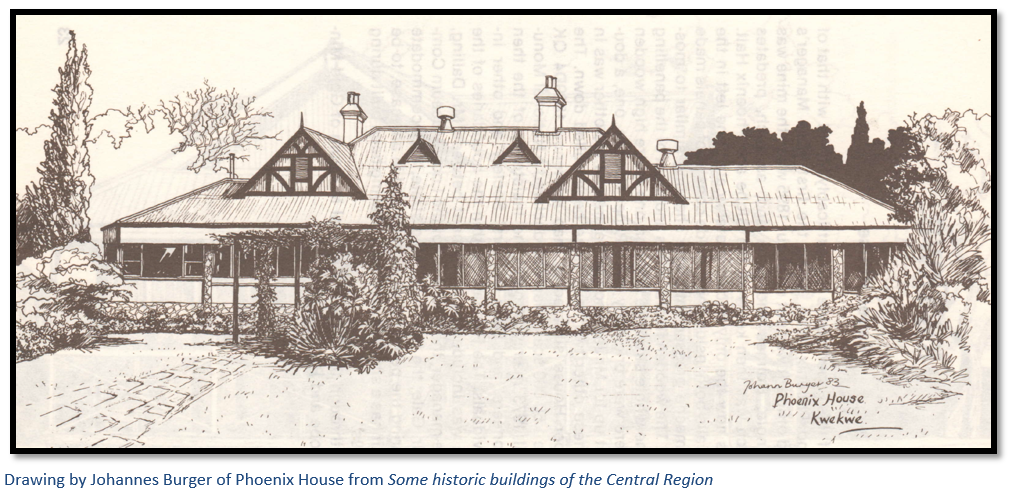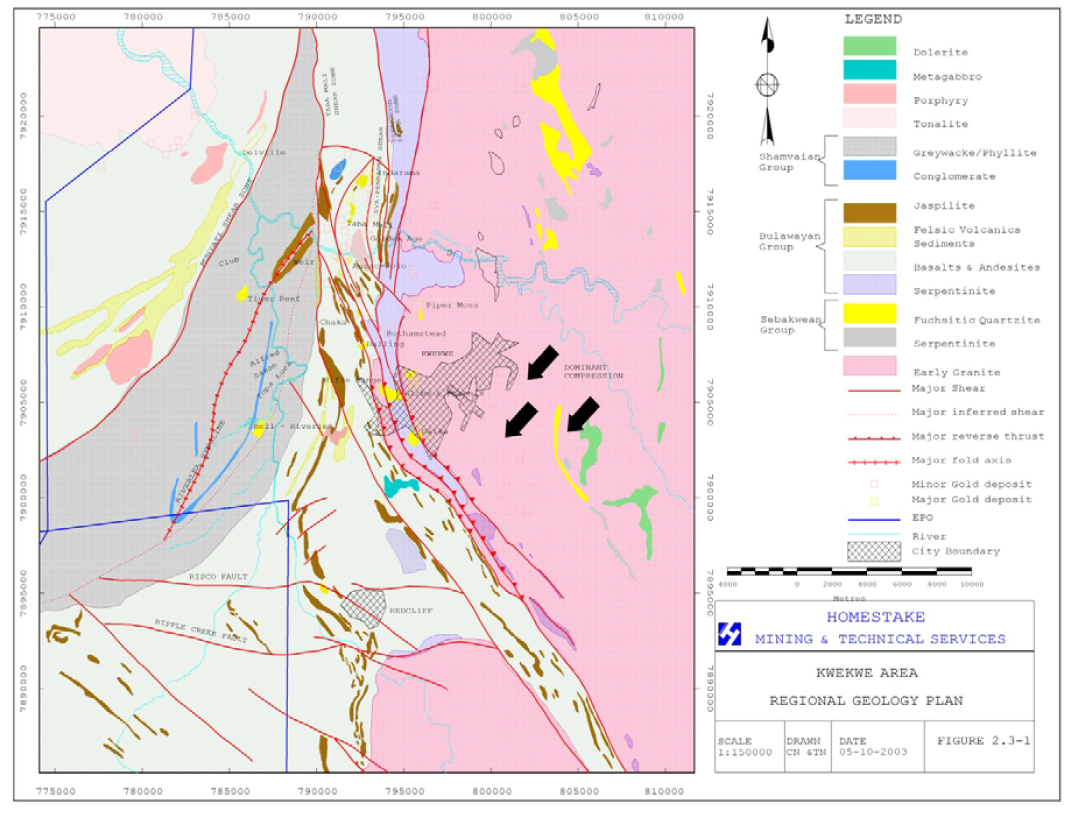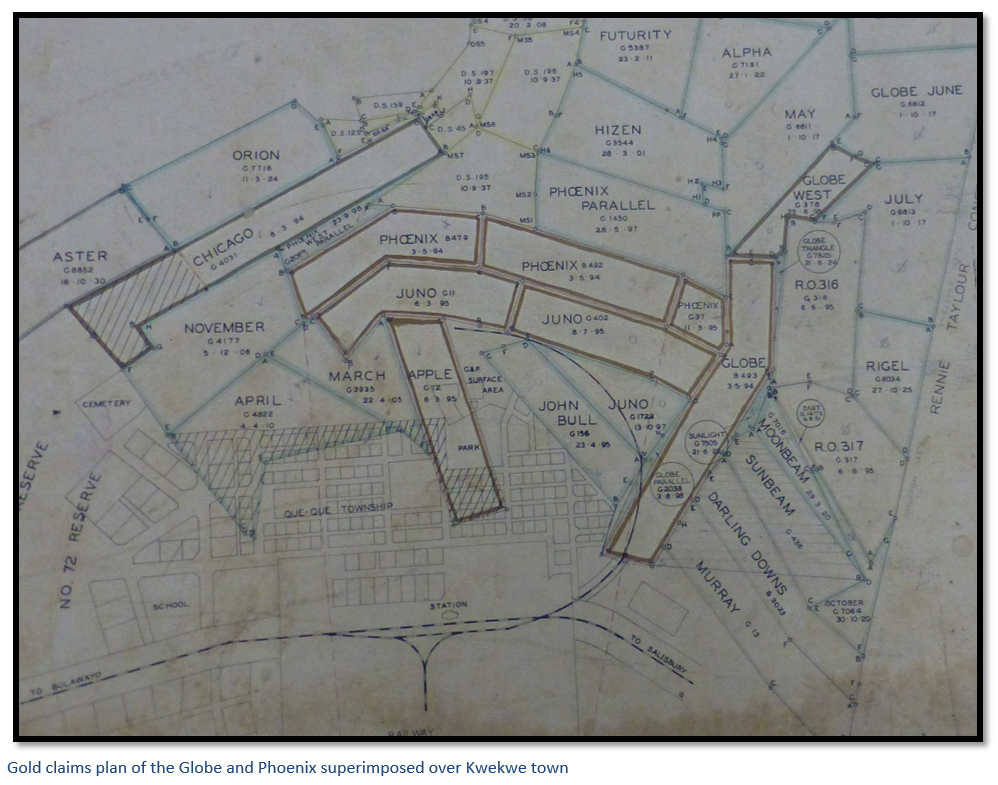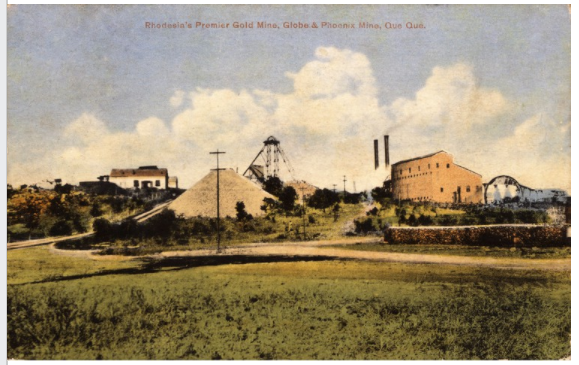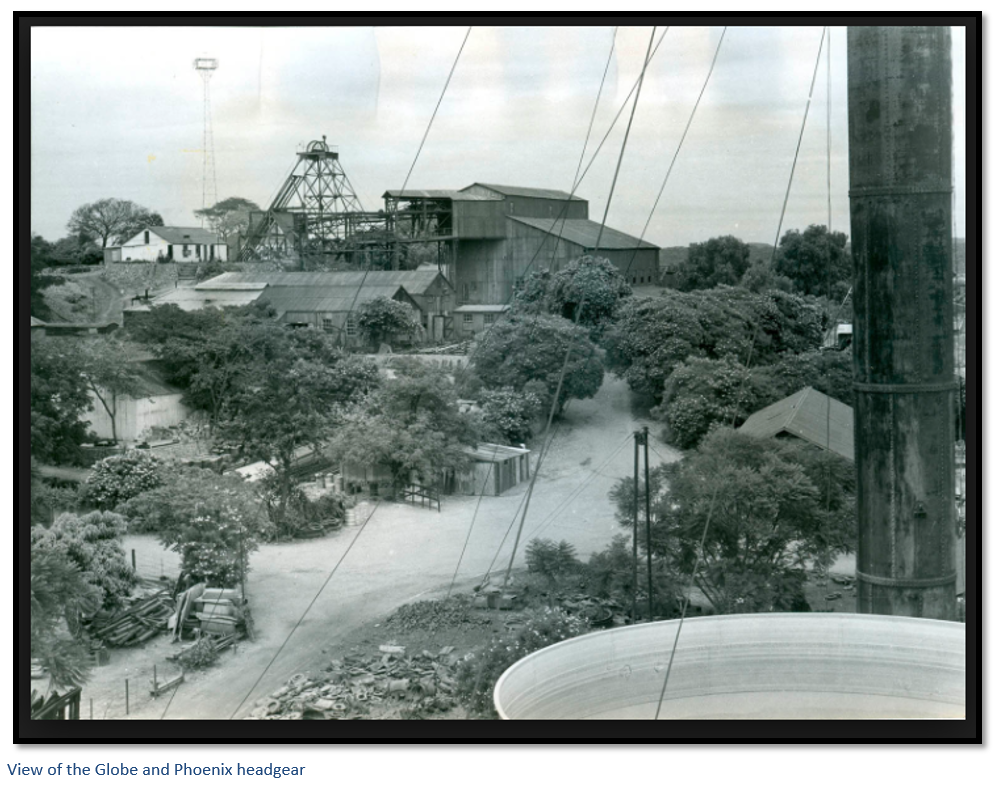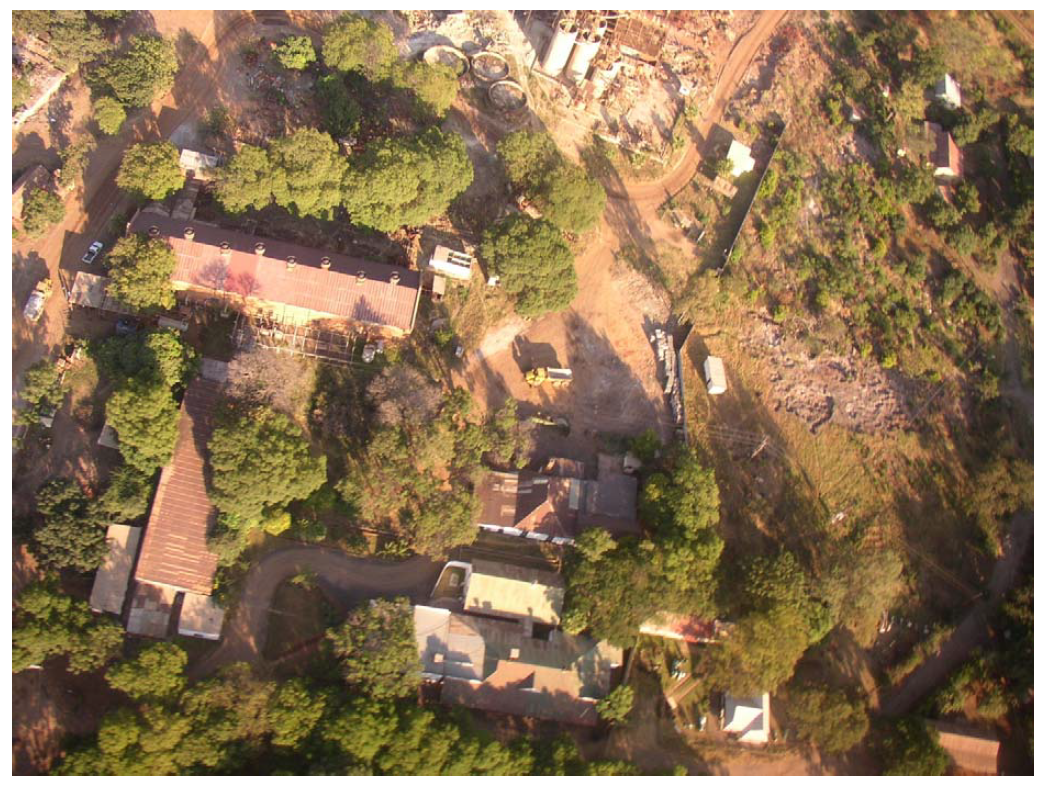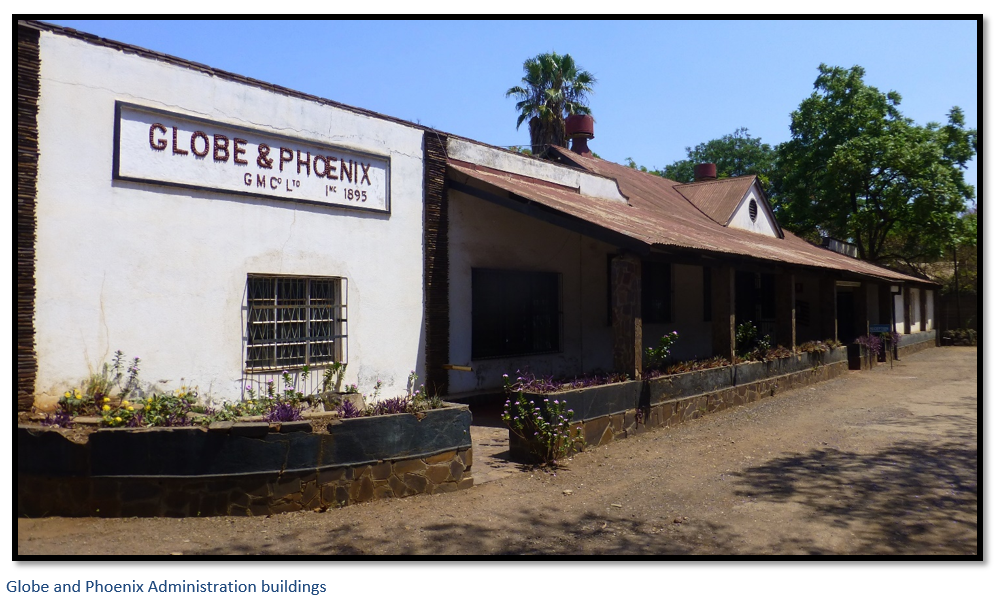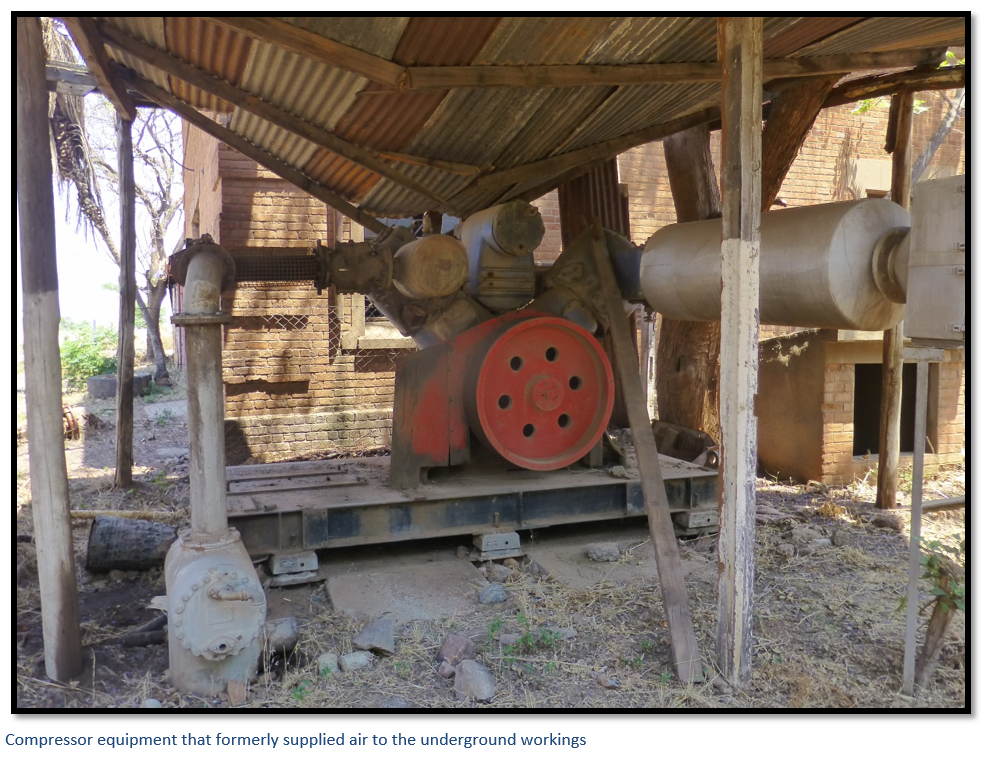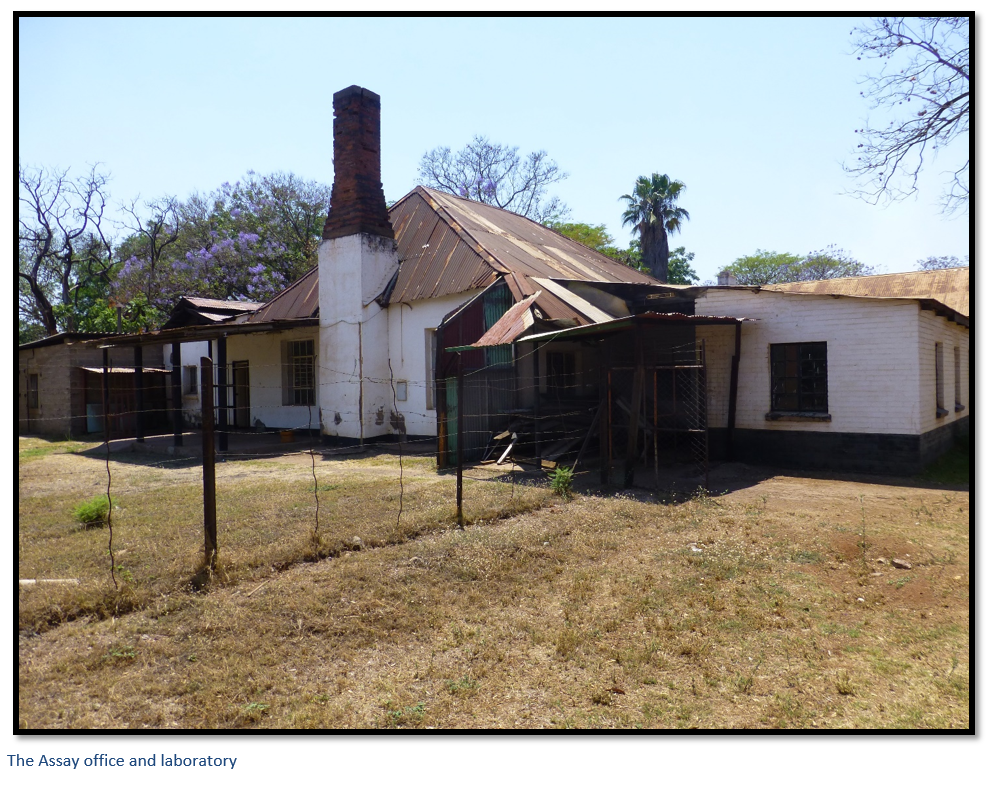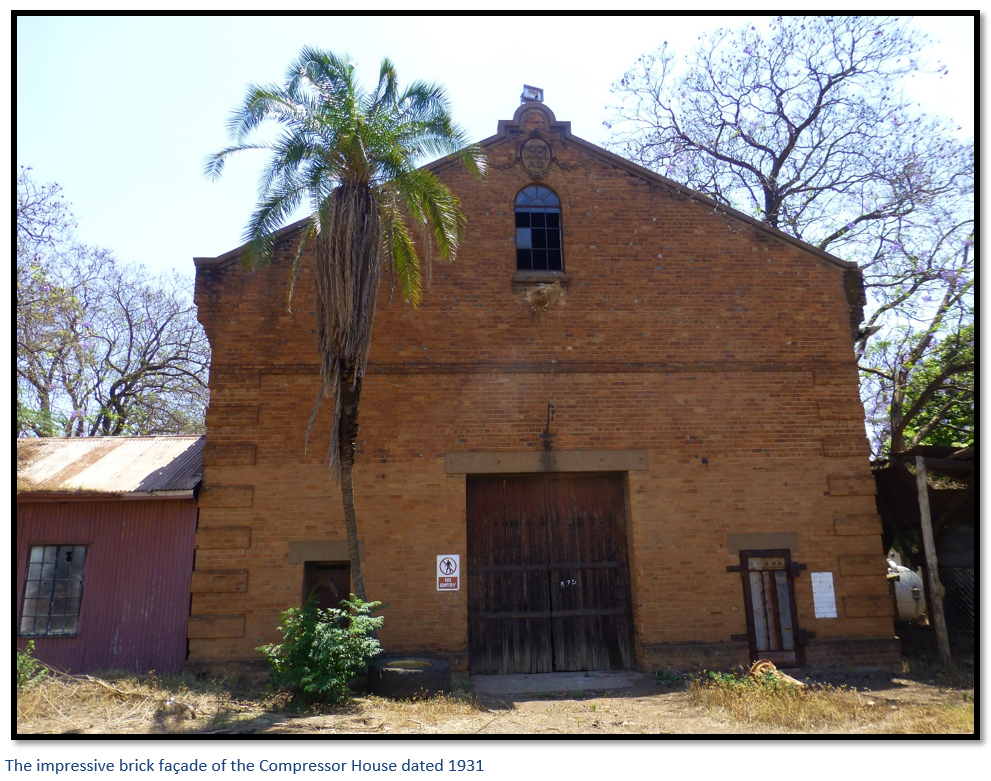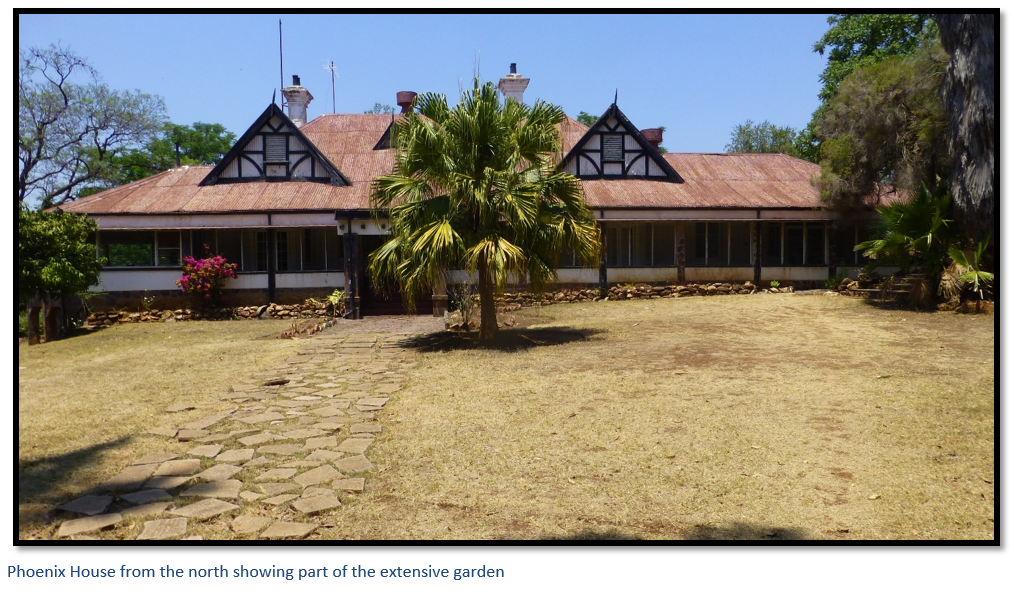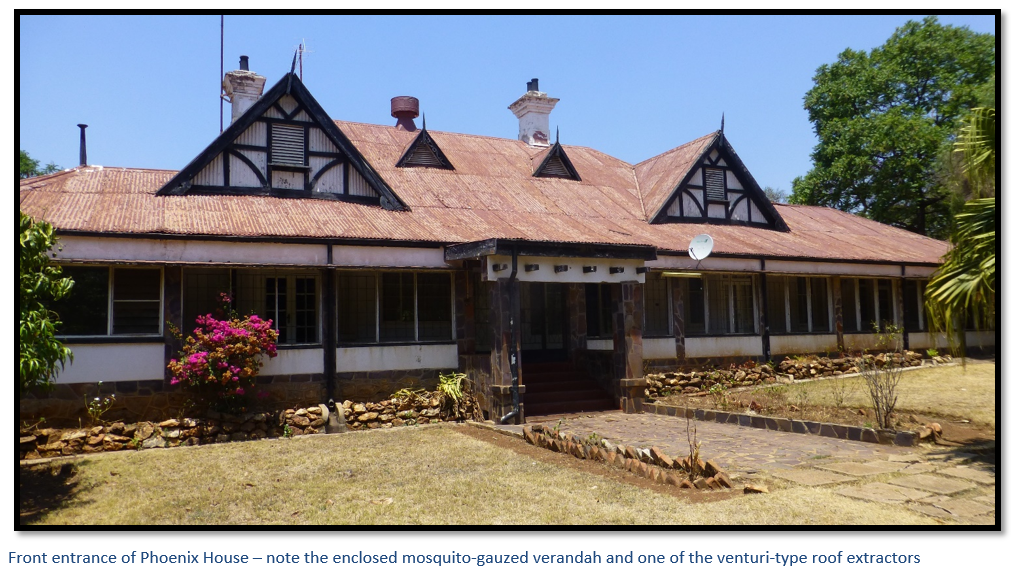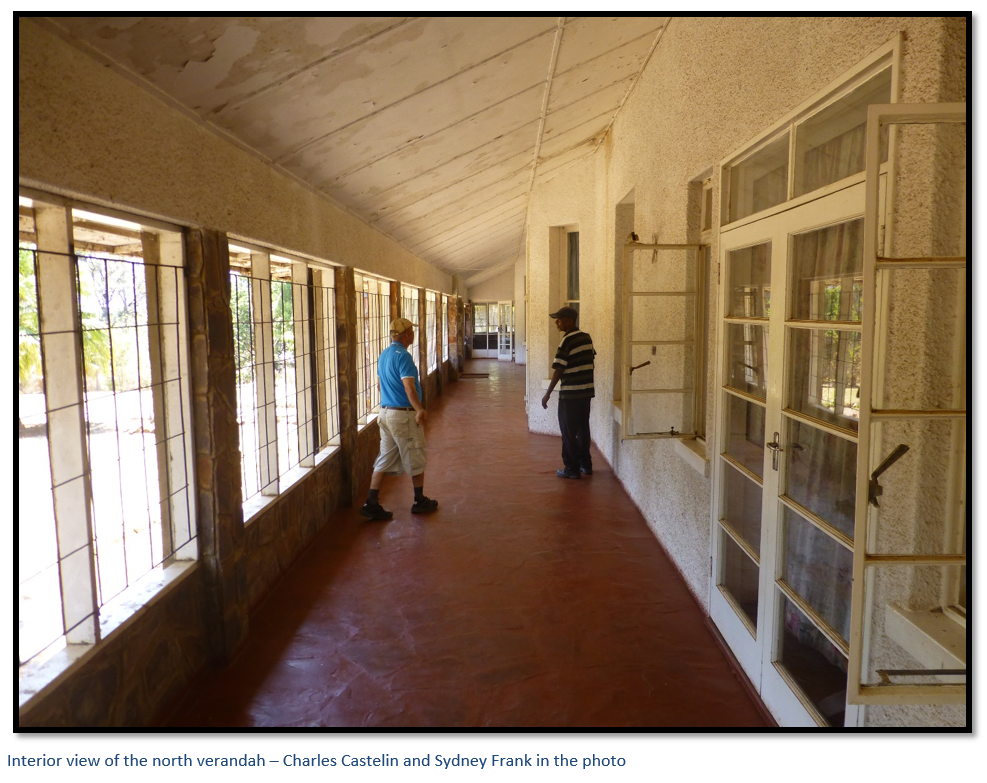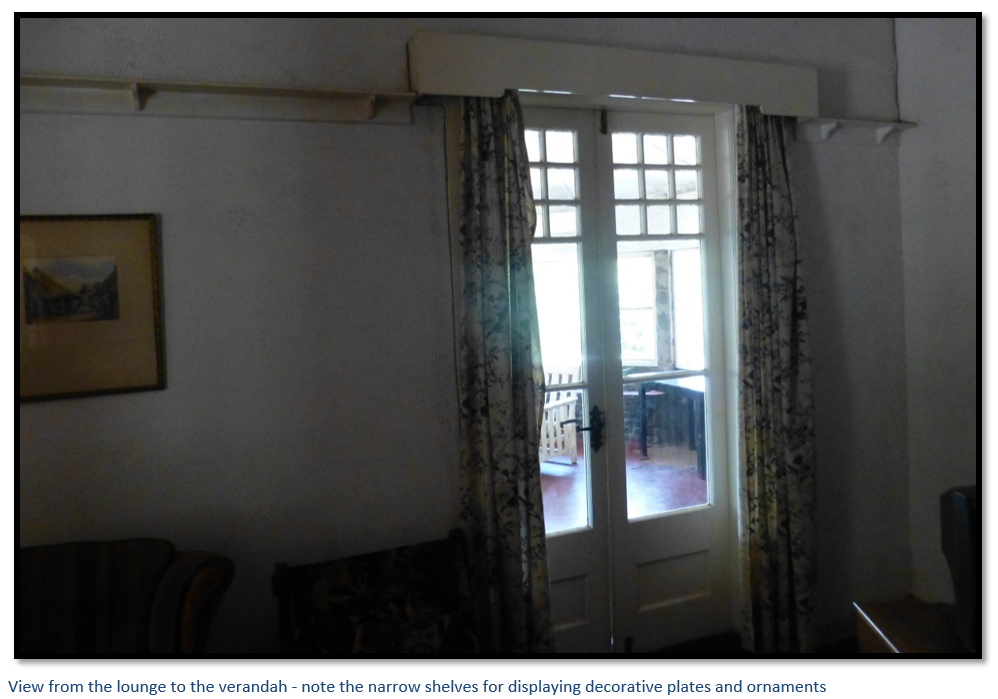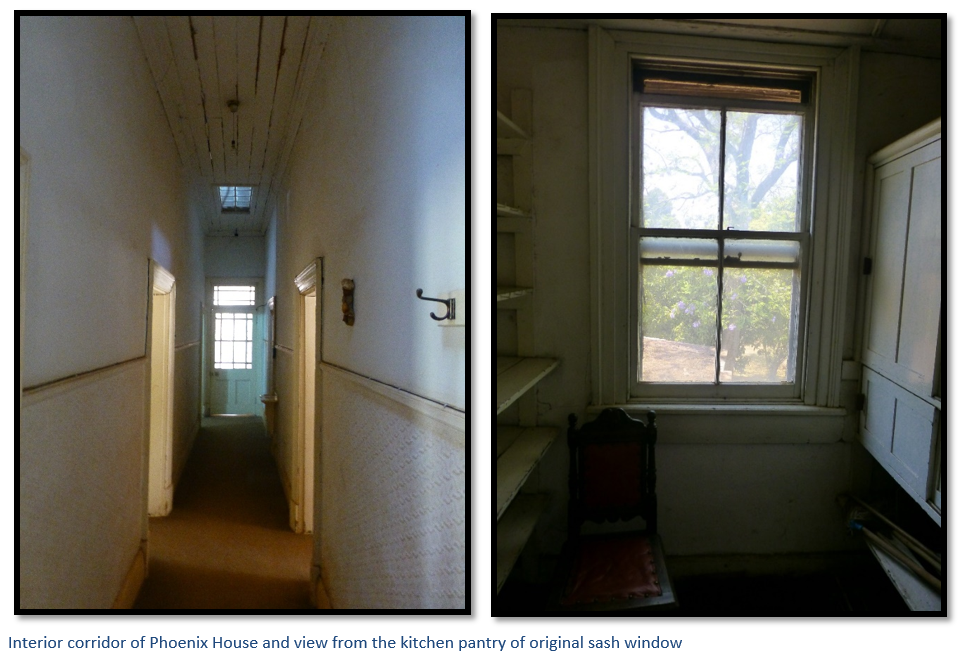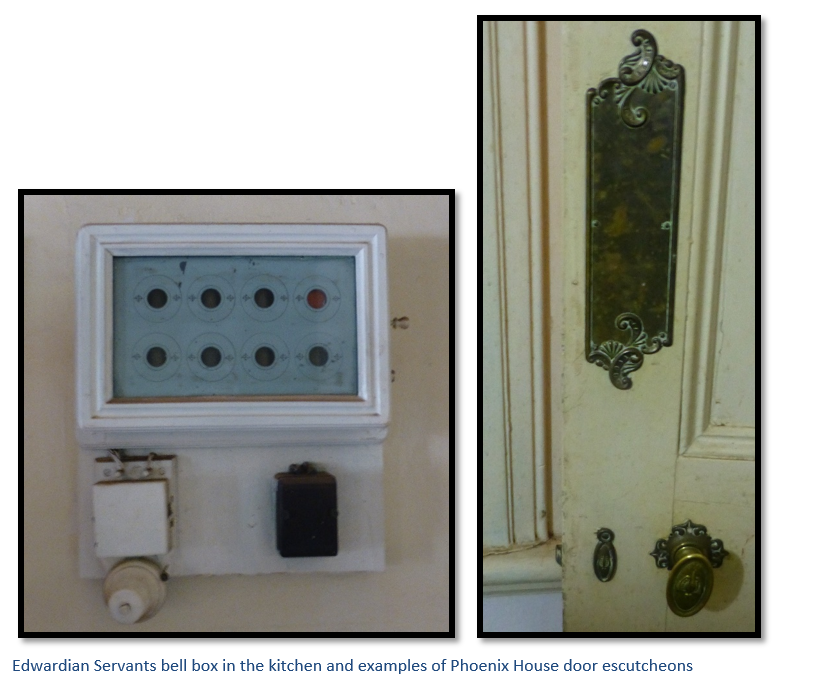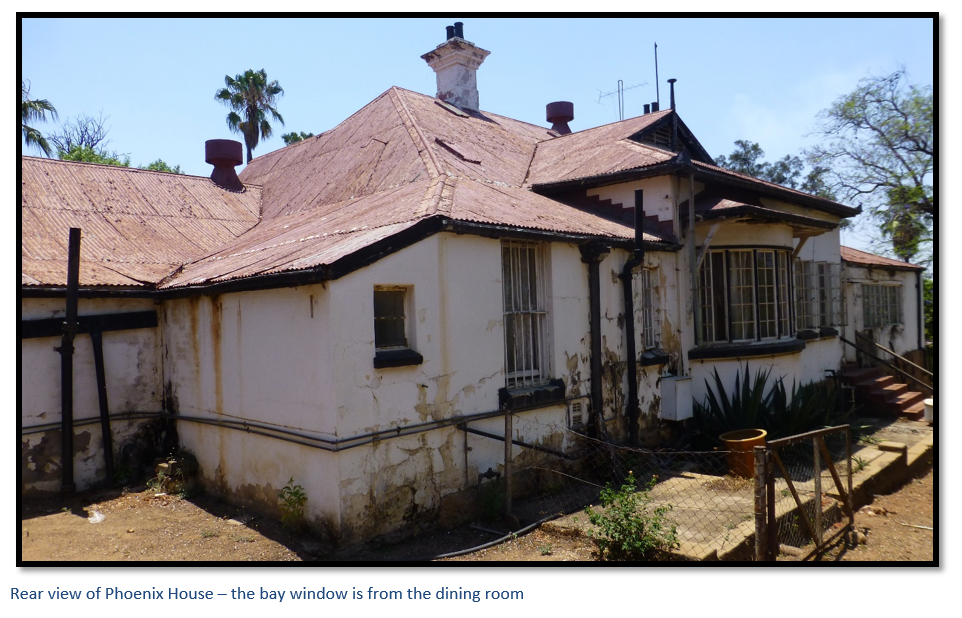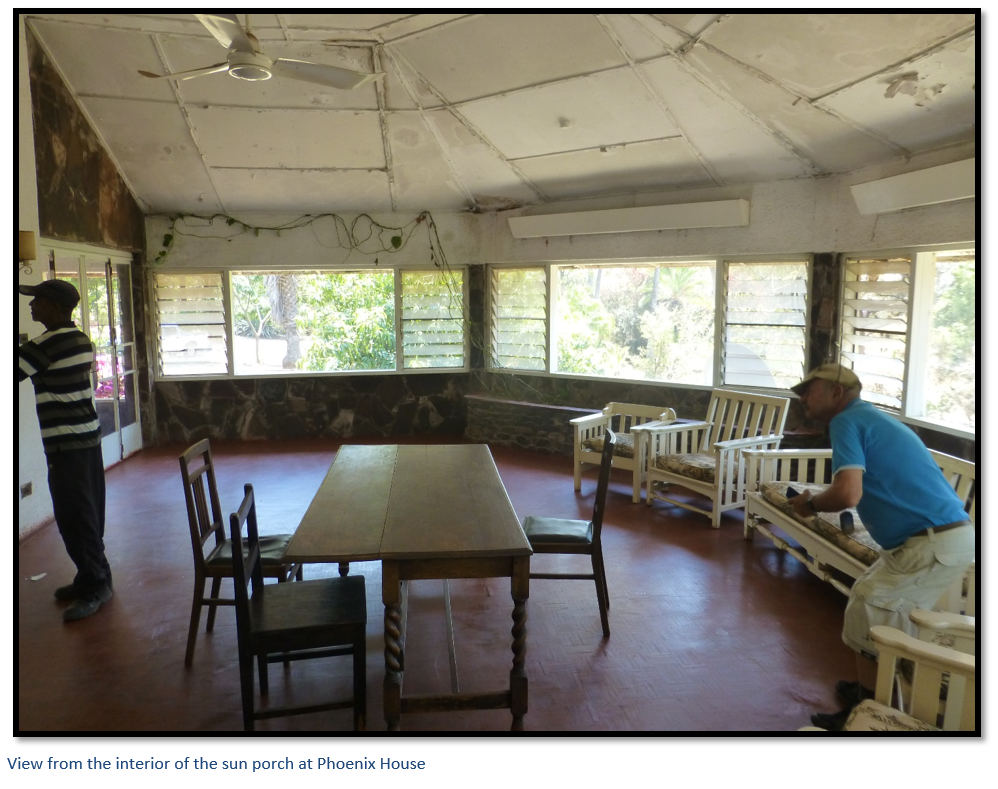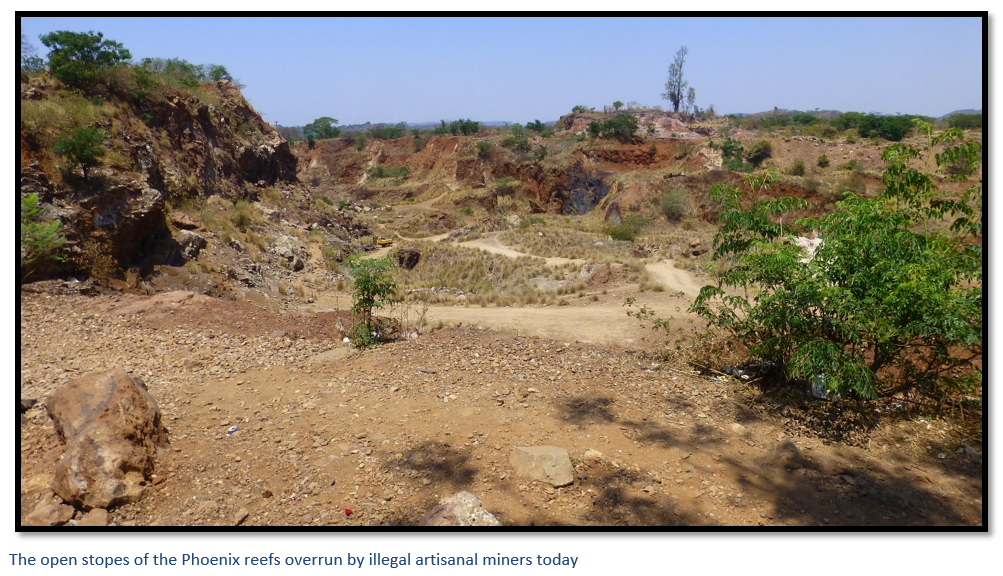Globe and Phoenix Mine Manager’s House
- The National Museums and Monuments Booklet Some Historic Buildings of the Central Region says that Phoenix House, the mine manager’s residence, was built in 1898, although other sources state 1902. It is a contemporary of the Gaika House, a few kilometres away to the south and with a similar, but smaller structure. [see the article on the Gaika House in Midlands Province]
- The Phoenix House, with its extensive gardens was built for the mine manager and succeeded the Paper House, a prefabricated two-bedroom dwelling built on wooden stilts in 1894, which was home to the first mine manager of the Globe and Phoenix Gold Mine, Mr H.A Piper. [see the article on the Paper House, including the National Mining Museum in Midlands Province] and was later used as his office.
- The Globe and Phoenix Mine is unique in Zimbabwe in that it is found on the western edge of Kwekwe just one hundred metres from the central business district. It is the second largest producer of gold in the country, after the Cam and Motor Mine at Kadoma and produced over 4.2 million ounces of gold in its lifetime at an average grade of 27.6 grams per ton. The mine made a very significant impact on the infrastructure and life of the town of Kwekwe.
- Most of the buildings in the G&P complex re pre-1910 and are classified as historical buildings worthy of preservation including the Phoenix House, the Paper House, the Mine Museum, the Administration Building and the Compressor House.
- The Phoenix House included of a lounge, dining room, four bedrooms, bathrooms, kitchen and a sun porch with stone fire-places in the lounge and main bedroom. The ceilings are high to keep the house cool and the northern and western sides have an enclosed verandah protected by mosquito-gauze. On the roof are two large venturi-type air extractors which combined with perforated panels in the ceilings will have contributed to keeping the house cool in the hot season. Out-buildings consist of servant’s quarters, an office and garage.
- The recent photographs were all taken in October 2017 with Charles Castelin...the visit was kindly arranged by Lee John of BioMettallurgical
From Harare follow the A5 national road into Kwekwe. After the roundabout and its adjacent prominent mosque, take the first road right and drive up the hill. At the Globe and Phoenix Club the road forks with the mine administration area directly in front. The Paper House is one hundred metres along the right fork, the Phoenix House is one hundred metres along the left fork.
Diana Polisensky tells us that Mr R.J. Allwright was its first resident and began its extensive gardens, the length of Silver Oaks Road with a thatched summer house and tennis court at the bottom of the garden where tea was served between games. Mr W.P. Watt was mine manager from 1946-56. Mr W.R. Atkinson was the last manager of the Globe and Phoenix Gold Mining Company which was sold in 1987 and the founder of the mining museum and his wife wrote the historical article on the Globe and Phoenix Mine which is referenced below.
Pre-European mining at what became the Globe and Phoenix Mine
Roger Summers in his book on Ancient Mining in Rhodesia describes the Phoenix reef and the Parallel reef as being about 270 metres apart on the top of the low hill to the west of Kwekwe as being on the contact zone between granite and basement schist. In 1969 when the book was published an ancient stope following the quartz reef about 1.2 metres wide and dipping at 50° was still in existence as the uppermost section of the mine ventilating system. At its base of 38 metres deep the stope was still clear of water and giving values of 31 grams (a troy oz) of gold per tonne; G.L.T. Dalling the mine manager in the 1960’s, estimated that about 30,000 oz of gold had been mined from this main stope.
The Globe stopes at the foot of Phoenix Hill were as large as the Phoenix stopes, but not as deep and the lateral extensions of the reef which were hidden from the early miners and not mined by them gave values of 56 grams (1.8 oz) of gold per tonne. In all, Summers estimated over 1,550 kilograms (50,000 oz) of gold output was taken by pre-European miners from these stopes.
Initial Discovery of the Globe and Phoenix Mine
The Globe and Phoenix Mine discovery by Europeans was typical of many gold reef discoveries in Zimbabwe. In 1894, two prospectors, Edward Thornton Pearson and Joseph Schukala equipped with little more than donkeys, blankets, prospecting pans and some supplies arrived in the district between the Kwekwe and Sebakwe Rivers. In exchange for blankets local Africans showed them some “ancient workings.” Most of the following is from Mirleen Atkinson’s article.
Schukala pegged claim Number B 493 and named them the Globe Reefs where the ancient workings were over 200 metres long on the main reef and 104 metres on the parallel, but no deeper than 27 metres. Pearson pegged two blocks of claims registered as Numbers B479 and B492 along the ridge where the reefs extended in a double line for about 122 metres and followed the quartz down for 38 metres on the Phoenix Reef and 11 metres on the parallel reef. Indications are that pre-European miners were recovering over 28 grams (one ounce) per tonne and the joint output at these sites from pre-colonial mining has been estimated at over 1.4 tonnes (50,000 ounces) of gold.
Both men registered their claims in Bulawayo in May 1894; but as they had no capital there was no possibility of either of them exploiting their finds. They planned to sell to the highest bidder and legend has it that Schukala initially tried to sell his claim for a case of whisky!
In September 1894 both claims were bought by Lionel Phillips who later wrote: “I met a prospector named Pearson who told me of a very large old working he had pegged. This country was very little known. We travelled on horseback with pack donkeys. We examined the old workings and were able to go down over 100 feet in one part and found the reef as it had been left by the ancients. In many parts you could see the reef at from 30 to 50 feet in depth. This was the Phoenix reef. About 500 yards distant was the Globe reef which had been pegged by Schakala (sic) No work had been done on either of the properties by the prospectors. I returned to my camp at Gwelo with Pearson and Schakala and eventually bought both the Globe and Phoenix reefs for the Phillips Exploration Syndicate.”
The Globe was bought by the Phillips Exploration Syndicate for £300 cash and 500 on £1 shares, the Phoenix for £600, along with other, but smaller claims on the Globe Parallel, Phoenix Parallel and Apple Reefs. The cash paid in gold sovereigns at Shepherds Beer Hall in Gwelo (now Gweru) where many business transactions took place in those days. So favourable was the 1895 consultant’s report that Lionel Phillips left at once for England to float the Globe and Phoenix Company which was incorporated on 18 October 1896 in England with a capital of £175,000 in £1 shares.
Early Development and later history
A telephone line was connected to Fort Que Que, a British South Africa Police post, and then Gwelo (now Gweru) in 1898. [see the article on Fort Que Que in Midlands Province] Present-day Kwekwe, was then called Sebakwe, but with the development of the Globe and Phoenix Mine, the few inhabitants of the original Kwekwe began to drift over to Sebakwe. In 1895, a post office was set up, a wood and corrugated building about 3 metres x 3 metres in extent., near the rail siding. The postmaster, F.W. Dennison had a sixteen-year-old learner postmaster, A.E. Hobbs to aid him who was so short he had to stand on a box to see over the counter, but in due course Hobbs retired as postmaster Bulawayo.
Drinking water was hauled from the Sebakwe River by ox-wagon, but after a legal wrangle in 1898 the Globe and Phoenix obtained permission to pump water via an eight-kilometre pipeline from the Sebakwe River.
In the same year, after delays due to the Matabele Uprising / Umvukela, and an outbreak of rinderpest which killed all the oxen used to pull the ox-wagons, construction began on the gold processing plant, although the outbreak of the Anglo Boer War in October 1899 prevented the cyanide plant from being delivered. The forty-stamp mill produced the first gold in August 1900; in the first trial of 24 days it crushed 5,907 tons of ore and recovered 4,742 ounces of gold (25g/t) with Me Allwright as first manager and a staff of twelve Europeans. By 1935 the Globe and Phoenix mine had produced nearly an ounce of gold for every ton milled and was described as the highest grade mine in the world and included amongst its Directors the Governor of the Bank of England.
Other notable highlights were the construction of a cyanide plant from March 1901 and the railway line arriving from Salisbury (now Harare) on 5 November 1901 before connecting with Bulawayo in November 1902 and being opened to traffic on 1 December 1902. Before this, the journey to Gweru by donkey cart took three days; now the rail journey took four hours as long as the engine driver was not tempted by a herd of antelope to stop and shot an animal ‘for the pot.’ One Kwekwe inhabitant remembers a train journey when the train was stopped to allow two men in a violent argument to settle their difference in a fistfight! The rail siding was then called Globe and Phoenix but renamed Que Que on 1 January 1924.
The first butchery and general store was opened in 1902 by John Austen, but the mine opened its own general dealers store the next year with H.W. Boby as manager and brought down the often-exorbitant prices which had been charged previously. A mine club was opened in 1902 with a bar and billiards room and there were two enthusiastic cricket teams and a rugby team. An away game in Bulawayo entailed taking a week’s leave with the journey time!
Fire was a major early peril; Pike’s Hotel burnt down in 1901 and Stankey’s Hotel and the bakery next door were burnt down in 1904.
On 20th August 1902, Sebakwe was renamed Que Que (now Kwekwe) and a village management board took over with the general manager of the Globe and Phoenix mine as first chairman. By 1903, there were eighteen European women residents. The mine continued to prosper, and more mine workers had to be recruited from as far away as Zambia and Malawi.
On the 3rd February 1905, the mine surface magazine with about seven tons of explosive accidently blew up making a huge crater and shaking the town and blowing all the liquor bottles off the shelves of the Mitchell’s Hotel.
By 1907 the Globe Reef shaft had reached 12 level, but mining operations ceased due to the low grades at depth. Mining continued on the Phoenix Reef and in 1911 – 12 the Phoenix Parallel claims and the John Bull claims were bought from Amalgamated Properties Rhodesia Limited.
Dispute over extra lateral rights – the longest and most costly in Rhodesia (now Zimbabwe)
By 1909, the Globe and Phoenix was in full production. Many claims were pegged as close to the Globe and Phoenix (G&P) as possible and a dispute arose in 1914 when Amalgamated Properties of Rhodesia Ltd sued the G&P for a half share of the gold extracted from a vertical of the John Bull Block that intersected the Phoenix Parallel. The court case was the longest and most costly in the history of Southern Rhodesia (now Zimbabwe) and England and went all the way through the Court of Appeal in 1917 to the House of Lords in 1919. It was known as the “John Bull” case. Mr Justice Eve listened to Mr Upjohn’s appeal speech and wrote some poetry, the last verse of which reads:
Tell me the same old story
Of fissure veins from hell,
Of Phoenix and its glory
The Main and Parallel.
The second case was in 1933, when Rhodesia Corporation Ltd, (successors to Amalgamated Properties) claimed the G&P Phoenix parallel was encroaching on their Northern Extension Reef. The courts ruled in favour of the G&P in both cases.
In 1936 the Globe Reef mine was re-opened and in the 1950’s the classic court case on extra lateral rights was heard in England.
In 1987 the Globe and Phoenix Gold Mining Company was sold to Tabex Mining Company, who sold on to Falcon Gold Company in 1995. Falcon in turn sold the Globe and Phoenix on to Delta Zimbabwe in 1997 and in 2002 they sold on to BioMetallurgical Zimbabwe Private Limited.
Globe & Phoenix | |||||||
Ore processed | Production | Production | Peak Production | Average Grade per tonne | |||
Tonnes | Kgs | oz's | oz's | grams | oz's | pwts | |
Production 1923 -2004 | 4,754,855 | 131,234 | 4,219,271 | 120,000 | 27.6 | 0.887 | 17.8 |
Flu Pandemic in 1918
Mirleen Atkinson writes that the 1918 flu pandemic, often called the Spanish Flu because newspaper reports were severely censored in most countries, but not in Spain, which ran from January 1918 – December 1920 affected Que Que severely. At one point, of the four hundred underground workers, only nineteen turned up for work with most of the hospital staff ill and Dr Davey himself administering help and advice from his sick bed. The Club hall became a temporary hospital and ten of the G&P’s European staff died and about three hundred Africans.
There were eight deaths recorded for October with the ninth dying on 2 November 1918.
Holdstock, James William. 13 Oct 1918 (age 44)
Reynolds, Oliver. 17 Oct 1918 (age 35)
Thaunderfelt, Gustav. 21 Oct 1918 (age 32)
Graydon, Joseph. 21 Oct 1918 (age 44)
Kay, Arthur Douglas. 22 Oct 1918 (age 26)
Omar, Hassan. 24 Oct 1918 (age 30)
Lopis, Philip. 25 Oct 1918 (age 27)
Green, Lillian Florence. 26 Oct 1918 (age 23)
Dundas, William Duncan Alexander. 2 Nov 1918 (age 28)
Geology
The Globe and Phoenix ore bodies were formed when the granites intruded from the east into the host magnesium carbonate and talc-schists of the Bulawayan and Sebakwean Groups of ultra-basic rocks. Thee produced stress-induced fissures into which were injected quartz reefs holding gold and antimony which comprise the Globe and Phoenix reefs which dip east at an angle of 60°or more.
The major orebodies comprise the Phoenix Main and Parallel Reefs are made up of a large number of quartz veins dipping to the east and merging before 8 level and have been mined to 44 level (1,400 metres vertical) Ore is generally free-milling with the gold occurring close to the granite contact, although there are patches of refractory ore. The Phoenix Reef was mined to 43 level following narrow quartz veins less than a metre wide with recoveries of up to 31 grams (1oz) per tonne.
Mining
On the Phoenix Mine 43 level is the lowest. The Phoenix No 1 incline shaft serves the upper 19 levels. Phoenix No 2 or ‘Bongola’ shaft gives additional access for miners and ore movement from surface to 7 level. The John Bull vertical shaft provides entry from surface to 21 level and the Rix sub-vertical shaft continues from 21 level to 39 level. There are connections from the John Bull vertical shaft at levels 8, 14, 19 and 21.
4 level on the Globe Mine connects with 5 level on the Phoenix Mine.
Underground mining uses jack hammers and as the Phoenix Mine follows quartz reef, shaft pillars were left all the way down. Broken ore is removed through box draw points on the footwall haulage ways into hand-trammed, or diesel hauled locos.
Currently all the mine workings are flooded from 3 level.
Processing
Delta Gold Zimbabwe built a carbon-in-Pulp (CIP) plant in 1996 with a milling plant capacity of 30,000 tonnes per month of sulphide and oxide ores. Once hauled from underground the ore goes from a rough ore bin to jaw crusher and then by conveyor to a sizing screen where over-sized material is circulated back to the crushing circuit.
Undersized ore is fed into an 8’ x 16’ ball mill which can mill 1,000 tonnes per day. The milled ore goes into thickeners and then CIP tanks for cyanidation where the gold in solution is adsorbed into carbon. Leached pulp is sent to the tailings dam; pregnant carbon is eluted and then recovered from the loaded eluate by an electrowinning process which collects the gold on a steel wool cathode.
Phoenix House today
A Kwekwe legacy problem with artisanal gold mining today
A large crack in the ground just 30 metres to the west of Phoenix House highlights the contemporary problem being created by artisanal miners cutting away the rock pillars supporting underground workings which is causing surface subsidence and has resulted in several collapses resulting in surface craters. Below level 3 the underground tunnels and stopes have become flooded, but those near the surface are being illegally mined out with no regard for safety, human life or the environment and there is a fear of further collapses.
Artisanal miners and panners contend that they are willing to mine the gold bearing ore despite the complete absence of safety and danger to their lives because the economic situation in Zimbabwe means this is the only way they can support their families.
Thanks
Thanks to the following: Charles Castelin who made the arrangements and accompanied me to Phoenix House; Lee John of BioMetallurgical who authorised and facilitated our visit; Mrs Lunda who met us at the Globe and Phoenix; Sydney Frank who guided us around the mine complex and Phoenix House.
References
Diana Polisensky (www.oncecalledhome.com)
R. Summers. Ancient Mining in Rhodesia. Trustees of the National Museums of Rhodesia. 1969.
M. Atkinson. History of the Globe and Phoenix Mine. Heritage of Zimbabwe Publication No.16 1997 P67-72
D. Polisensky. http://www.oncecalledhome.com/2012/09/the-depression-que-ques-lucky-break/
D. Polisensky. http://www.oncecalledhome.com/2012/08/down-in-the-dumps
National Museums and Monuments of Zimbabwe. Some historic buildings of the Central Region.
Source: (Geni Records)
Wikipedia

